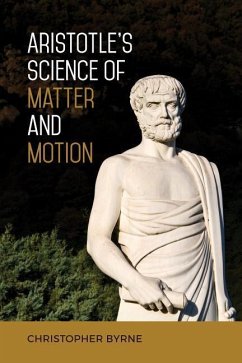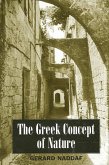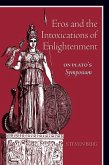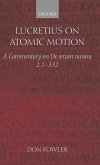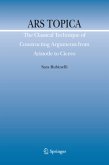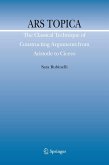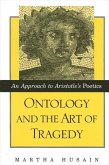Christopher Byrne
Aristotle's Science of Matter and Motion
Christopher Byrne
Aristotle's Science of Matter and Motion
- Gebundenes Buch
- Merkliste
- Auf die Merkliste
- Bewerten Bewerten
- Teilen
- Produkt teilen
- Produkterinnerung
- Produkterinnerung
Although Aristotle’s contribution to biology has long been recognized, there are many philosophers and historians of science who still hold that he was the great delayer of natural science, calling him the man who held up the Scientific Revolution by two thousand years.
Andere Kunden interessierten sich auch für
![The Greek Concept of Nature The Greek Concept of Nature]() Gerard NaddafThe Greek Concept of Nature113,99 €
Gerard NaddafThe Greek Concept of Nature113,99 €![Eros and the Intoxications of Enlightenment Eros and the Intoxications of Enlightenment]() Steven BergEros and the Intoxications of Enlightenment113,99 €
Steven BergEros and the Intoxications of Enlightenment113,99 €![Apology of Socrates and Crito Apology of Socrates and Crito]() PlatoApology of Socrates and Crito37,99 €
PlatoApology of Socrates and Crito37,99 €![Lucretius on Atomic Motion Lucretius on Atomic Motion]() Don FowlerLucretius on Atomic Motion406,99 €
Don FowlerLucretius on Atomic Motion406,99 €![Ars Topica Ars Topica]() Sara RubinelliArs Topica83,99 €
Sara RubinelliArs Topica83,99 €![Ars Topica Ars Topica]() Sara RubinelliArs Topica83,99 €
Sara RubinelliArs Topica83,99 €![Ontology and the Art of Tragedy: An Approach to Aristotle's Poetics Ontology and the Art of Tragedy: An Approach to Aristotle's Poetics]() Martha HusainOntology and the Art of Tragedy: An Approach to Aristotle's Poetics109,99 €
Martha HusainOntology and the Art of Tragedy: An Approach to Aristotle's Poetics109,99 €-
-
-
Although Aristotle’s contribution to biology has long been recognized, there are many philosophers and historians of science who still hold that he was the great delayer of natural science, calling him the man who held up the Scientific Revolution by two thousand years.
Hinweis: Dieser Artikel kann nur an eine deutsche Lieferadresse ausgeliefert werden.
Hinweis: Dieser Artikel kann nur an eine deutsche Lieferadresse ausgeliefert werden.
Produktdetails
- Produktdetails
- Verlag: University of Toronto Press
- Seitenzahl: 208
- Erscheinungstermin: 11. Juli 2018
- Englisch
- Abmessung: 236mm x 159mm x 25mm
- Gewicht: 496g
- ISBN-13: 9781487503963
- ISBN-10: 1487503962
- Artikelnr.: 52420552
- Herstellerkennzeichnung
- Libri GmbH
- Europaallee 1
- 36244 Bad Hersfeld
- gpsr@libri.de
- Verlag: University of Toronto Press
- Seitenzahl: 208
- Erscheinungstermin: 11. Juli 2018
- Englisch
- Abmessung: 236mm x 159mm x 25mm
- Gewicht: 496g
- ISBN-13: 9781487503963
- ISBN-10: 1487503962
- Artikelnr.: 52420552
- Herstellerkennzeichnung
- Libri GmbH
- Europaallee 1
- 36244 Bad Hersfeld
- gpsr@libri.de
Christopher Byrne is an associate professor in the Department of Philosophy at St. Francis Xavier University.
Preface
Acknowledgments
Introduction: The Case against an Aristotelian Physics
1 Motion and Change in Perceptible Objects
1.1 The Common Attributes of Perceptible Objects
1.1.1 Perceptible Objects and Physical Contact
1.1.2 Perceptible Objects and Motion
1.1.3 Perceptible Objects and Change
1.2 Motion and Natural Motion
1.2.1 Motion and the Definition of Change
1.2.2 Motion and Place
1.2.3 Motion and Inertial Motion
2 E fficient Causality in Perceptible Objects
2.1 General Principles of Efficient Causality
2.1.1 Efficient Causality Belongs to Physical Agents
2.1.2 Causation by Internal Parts
2.1.3 Transmission Model of Causal Agency
2.1.4 Causation by Commensurate Powers
2.2 Mechanics and the Laws of Nature
2.2.1 No Action at a Distance
2.2.2 Proportion of Change to Physical Contact
2.2.3 Spatial Dissipation of Causal Influence
2.2.4 Combination of Causal Powers
2.2.5 Necessity of Prior Motion
2.2.6 P roportion between Cause and Effect
2.2.7 Like Produces Like
2.2.8 Universal Application and Experiments
3 The Material Causes of Perceptible Objects
3.1 The Definition of a Material Cause
3.2 Perceptible Matter and the Division of the Sciences
3.3 The Physical Requirements for Motion and Change
3.3.1 The Substratum of Physical Interaction
3.3.2 The Substratum of Locomotion
3.3.3 The Substratum of Generation and Destruction
4 The Material Elements and Prime Matter
4.1 The Common Substratum of the Material Elements
4.2 The Generation of the Material Elements
5 Simple Physical Necessity in the Material Elements
5.1 Simple versus Hypothetical Necessity
5.2 Simple Teleological Necessity in the Elements
5.3 Simple Non-Teleological Necessity in the Elements
6 Simple Physical Necessity in Objects Made out of the Elements
6.1 Simple Teleological Necessity in Perceptible Objects
6.2 Simple Non-Teleological Necessity in Perceptible Objects
6.3 Generation of Homogeneous Mixtures
7 The Dual Nature of Perceptible Objects
7.1 The Dual Nature of Physical Artefacts
7.2 The Many Natures of Natural Substances
7.3 The Difference between Natural Substances and Physical Artefacts
7.4 The Unity of Natural Substances
8 Matter and the Soul
8.1 The Soul as the Actuality of the Body
8.2 The Soul and Efficient Causality
9 The Role of Teleological Explanation
9.1 The Limits of Teleological Explanation
9.2 The Compatibility of Natural Teleology with Non-Teleological Necessity
9.3 The Dependence of Natural Teleology on Non-Teleological Necessity
10 C onclusion: The Independence of the Material Cause
10.1 The Material Cause and the Substratum of Generation
10.2 The Material Cause and Potentiality
10.3 The Material Cause and Definition
10.4 The Material Cause and Change
Notes
Works Cited
Index of Texts from Aristotle
Acknowledgments
Introduction: The Case against an Aristotelian Physics
1 Motion and Change in Perceptible Objects
1.1 The Common Attributes of Perceptible Objects
1.1.1 Perceptible Objects and Physical Contact
1.1.2 Perceptible Objects and Motion
1.1.3 Perceptible Objects and Change
1.2 Motion and Natural Motion
1.2.1 Motion and the Definition of Change
1.2.2 Motion and Place
1.2.3 Motion and Inertial Motion
2 E fficient Causality in Perceptible Objects
2.1 General Principles of Efficient Causality
2.1.1 Efficient Causality Belongs to Physical Agents
2.1.2 Causation by Internal Parts
2.1.3 Transmission Model of Causal Agency
2.1.4 Causation by Commensurate Powers
2.2 Mechanics and the Laws of Nature
2.2.1 No Action at a Distance
2.2.2 Proportion of Change to Physical Contact
2.2.3 Spatial Dissipation of Causal Influence
2.2.4 Combination of Causal Powers
2.2.5 Necessity of Prior Motion
2.2.6 P roportion between Cause and Effect
2.2.7 Like Produces Like
2.2.8 Universal Application and Experiments
3 The Material Causes of Perceptible Objects
3.1 The Definition of a Material Cause
3.2 Perceptible Matter and the Division of the Sciences
3.3 The Physical Requirements for Motion and Change
3.3.1 The Substratum of Physical Interaction
3.3.2 The Substratum of Locomotion
3.3.3 The Substratum of Generation and Destruction
4 The Material Elements and Prime Matter
4.1 The Common Substratum of the Material Elements
4.2 The Generation of the Material Elements
5 Simple Physical Necessity in the Material Elements
5.1 Simple versus Hypothetical Necessity
5.2 Simple Teleological Necessity in the Elements
5.3 Simple Non-Teleological Necessity in the Elements
6 Simple Physical Necessity in Objects Made out of the Elements
6.1 Simple Teleological Necessity in Perceptible Objects
6.2 Simple Non-Teleological Necessity in Perceptible Objects
6.3 Generation of Homogeneous Mixtures
7 The Dual Nature of Perceptible Objects
7.1 The Dual Nature of Physical Artefacts
7.2 The Many Natures of Natural Substances
7.3 The Difference between Natural Substances and Physical Artefacts
7.4 The Unity of Natural Substances
8 Matter and the Soul
8.1 The Soul as the Actuality of the Body
8.2 The Soul and Efficient Causality
9 The Role of Teleological Explanation
9.1 The Limits of Teleological Explanation
9.2 The Compatibility of Natural Teleology with Non-Teleological Necessity
9.3 The Dependence of Natural Teleology on Non-Teleological Necessity
10 C onclusion: The Independence of the Material Cause
10.1 The Material Cause and the Substratum of Generation
10.2 The Material Cause and Potentiality
10.3 The Material Cause and Definition
10.4 The Material Cause and Change
Notes
Works Cited
Index of Texts from Aristotle
Preface
Acknowledgments
Introduction: The Case against an Aristotelian Physics
1 Motion and Change in Perceptible Objects
1.1 The Common Attributes of Perceptible Objects
1.1.1 Perceptible Objects and Physical Contact
1.1.2 Perceptible Objects and Motion
1.1.3 Perceptible Objects and Change
1.2 Motion and Natural Motion
1.2.1 Motion and the Definition of Change
1.2.2 Motion and Place
1.2.3 Motion and Inertial Motion
2 E fficient Causality in Perceptible Objects
2.1 General Principles of Efficient Causality
2.1.1 Efficient Causality Belongs to Physical Agents
2.1.2 Causation by Internal Parts
2.1.3 Transmission Model of Causal Agency
2.1.4 Causation by Commensurate Powers
2.2 Mechanics and the Laws of Nature
2.2.1 No Action at a Distance
2.2.2 Proportion of Change to Physical Contact
2.2.3 Spatial Dissipation of Causal Influence
2.2.4 Combination of Causal Powers
2.2.5 Necessity of Prior Motion
2.2.6 P roportion between Cause and Effect
2.2.7 Like Produces Like
2.2.8 Universal Application and Experiments
3 The Material Causes of Perceptible Objects
3.1 The Definition of a Material Cause
3.2 Perceptible Matter and the Division of the Sciences
3.3 The Physical Requirements for Motion and Change
3.3.1 The Substratum of Physical Interaction
3.3.2 The Substratum of Locomotion
3.3.3 The Substratum of Generation and Destruction
4 The Material Elements and Prime Matter
4.1 The Common Substratum of the Material Elements
4.2 The Generation of the Material Elements
5 Simple Physical Necessity in the Material Elements
5.1 Simple versus Hypothetical Necessity
5.2 Simple Teleological Necessity in the Elements
5.3 Simple Non-Teleological Necessity in the Elements
6 Simple Physical Necessity in Objects Made out of the Elements
6.1 Simple Teleological Necessity in Perceptible Objects
6.2 Simple Non-Teleological Necessity in Perceptible Objects
6.3 Generation of Homogeneous Mixtures
7 The Dual Nature of Perceptible Objects
7.1 The Dual Nature of Physical Artefacts
7.2 The Many Natures of Natural Substances
7.3 The Difference between Natural Substances and Physical Artefacts
7.4 The Unity of Natural Substances
8 Matter and the Soul
8.1 The Soul as the Actuality of the Body
8.2 The Soul and Efficient Causality
9 The Role of Teleological Explanation
9.1 The Limits of Teleological Explanation
9.2 The Compatibility of Natural Teleology with Non-Teleological Necessity
9.3 The Dependence of Natural Teleology on Non-Teleological Necessity
10 C onclusion: The Independence of the Material Cause
10.1 The Material Cause and the Substratum of Generation
10.2 The Material Cause and Potentiality
10.3 The Material Cause and Definition
10.4 The Material Cause and Change
Notes
Works Cited
Index of Texts from Aristotle
Acknowledgments
Introduction: The Case against an Aristotelian Physics
1 Motion and Change in Perceptible Objects
1.1 The Common Attributes of Perceptible Objects
1.1.1 Perceptible Objects and Physical Contact
1.1.2 Perceptible Objects and Motion
1.1.3 Perceptible Objects and Change
1.2 Motion and Natural Motion
1.2.1 Motion and the Definition of Change
1.2.2 Motion and Place
1.2.3 Motion and Inertial Motion
2 E fficient Causality in Perceptible Objects
2.1 General Principles of Efficient Causality
2.1.1 Efficient Causality Belongs to Physical Agents
2.1.2 Causation by Internal Parts
2.1.3 Transmission Model of Causal Agency
2.1.4 Causation by Commensurate Powers
2.2 Mechanics and the Laws of Nature
2.2.1 No Action at a Distance
2.2.2 Proportion of Change to Physical Contact
2.2.3 Spatial Dissipation of Causal Influence
2.2.4 Combination of Causal Powers
2.2.5 Necessity of Prior Motion
2.2.6 P roportion between Cause and Effect
2.2.7 Like Produces Like
2.2.8 Universal Application and Experiments
3 The Material Causes of Perceptible Objects
3.1 The Definition of a Material Cause
3.2 Perceptible Matter and the Division of the Sciences
3.3 The Physical Requirements for Motion and Change
3.3.1 The Substratum of Physical Interaction
3.3.2 The Substratum of Locomotion
3.3.3 The Substratum of Generation and Destruction
4 The Material Elements and Prime Matter
4.1 The Common Substratum of the Material Elements
4.2 The Generation of the Material Elements
5 Simple Physical Necessity in the Material Elements
5.1 Simple versus Hypothetical Necessity
5.2 Simple Teleological Necessity in the Elements
5.3 Simple Non-Teleological Necessity in the Elements
6 Simple Physical Necessity in Objects Made out of the Elements
6.1 Simple Teleological Necessity in Perceptible Objects
6.2 Simple Non-Teleological Necessity in Perceptible Objects
6.3 Generation of Homogeneous Mixtures
7 The Dual Nature of Perceptible Objects
7.1 The Dual Nature of Physical Artefacts
7.2 The Many Natures of Natural Substances
7.3 The Difference between Natural Substances and Physical Artefacts
7.4 The Unity of Natural Substances
8 Matter and the Soul
8.1 The Soul as the Actuality of the Body
8.2 The Soul and Efficient Causality
9 The Role of Teleological Explanation
9.1 The Limits of Teleological Explanation
9.2 The Compatibility of Natural Teleology with Non-Teleological Necessity
9.3 The Dependence of Natural Teleology on Non-Teleological Necessity
10 C onclusion: The Independence of the Material Cause
10.1 The Material Cause and the Substratum of Generation
10.2 The Material Cause and Potentiality
10.3 The Material Cause and Definition
10.4 The Material Cause and Change
Notes
Works Cited
Index of Texts from Aristotle

